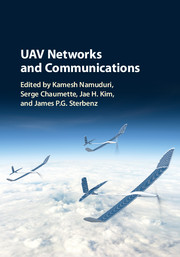Book contents
- Frontmatter
- Dedication
- Contents
- Preface
- Contributors
- 1 Introduction to UAV Systems
- 2 Air-to-Ground and Air-to-Air Data Link Communication
- 3 Aerial Wi-Fi Networks
- 4 Disruption-Tolerant Airborne Networks and Protocols
- 5 UAV Systems and Networks: Emulation and Field Demonstration
- 6 Integrating UAS into the NAS – Regulatory, Technical, and Research Challenges
- 7 Safety, Security, and Privacy Aspects in UAV Networks
- 8 Collaboration Between Autonomous Drones and Swarming
- 9 Real-World Applications
- References
- Index
2 - Air-to-Ground and Air-to-Air Data Link Communication
Published online by Cambridge University Press: 17 November 2017
- Frontmatter
- Dedication
- Contents
- Preface
- Contributors
- 1 Introduction to UAV Systems
- 2 Air-to-Ground and Air-to-Air Data Link Communication
- 3 Aerial Wi-Fi Networks
- 4 Disruption-Tolerant Airborne Networks and Protocols
- 5 UAV Systems and Networks: Emulation and Field Demonstration
- 6 Integrating UAS into the NAS – Regulatory, Technical, and Research Challenges
- 7 Safety, Security, and Privacy Aspects in UAV Networks
- 8 Collaboration Between Autonomous Drones and Swarming
- 9 Real-World Applications
- References
- Index
Summary
Wireless communication has always been essential, even in manned aviation, to ensure ground control of airplanes and airspace. In addition to wireless communication, radars operating on various radio bands have always been an essential part of any flight control system as they can give accurate information about aircraft locations. Given the tremendous improvements that have been realized in wireless communication over recent decades, first from analog to digital systems and then the digital scaling enabled by Moore's law, we see today a huge range of different technologies in use and sharing the same aerial spectrum. In this chapter, we will start by giving the background on wireless communication used in manned aviation from the early days. This includes radar as well as the early digital communication. We will then discuss two novel technologies currently being proposed for L-band Digital Aeronautical Communication. Finally, we will conclude with some fundamental insights, learned from experience with advanced terrestrial mobile broadband communication extrapolated to the aerial case relevant for aerial communication on unmanned and small UAVs. As technology scales, more and more processing power is available on ever smaller chips, yet to ensure good link budget and long distance communication, we also have to rely on fundamental properties of the electromagnetic waves and the wireless channel. We analyze the use of multiple antenna techniques, the breakthrough technology for improving communication range and rate in all terrestrial mobile broadband technologies of the last decade, and comment on their usability for unmanned small aerial vehicles.
Air-to-Ground Communication for Manned Aviation
Wireless technologies are commonly used in manned aviation. This section gives an overview of both radar and communication solutions for manned aviation. Systems for unmanned aerial vehicles can be seen as a revolution of these systems, combining legacy manned communication technology as a basis, with disruptive innovations from the mobile broadband communication scene. Nevertheless, for this book, we believe a comprehensive overview is useful for the reader.
Radar for Ground-based Aircraft Identification
In controlled airspace it is very important to accurately know the location of all participating traffic. This is done by two types of radar, that is the primary and secondary surveillance radars. We will first introduce both radar systems, and will then zoom in on the antenna typically used for such systems.
- Type
- Chapter
- Information
- UAV Networks and Communications , pp. 26 - 44Publisher: Cambridge University PressPrint publication year: 2017



